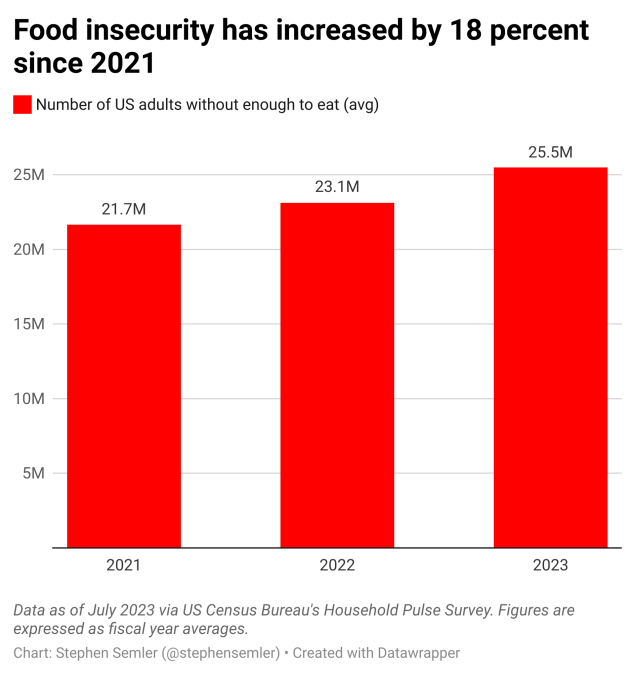Military Spending Is Soaring, Even as Food Insecurity Reaches New Heights
As US military spending balloons to record levels, new data show that the number of US adults who don’t have enough to eat has jumped for the fourth straight month. The massive military budget is quite literally taking food out of people’s mouths.

Similar to how America funded its war on terror, the United States is underwriting its involvement in the war in Ukraine almost entirely with “emergency spending.” (Mustafa Ciftci / Anadolu Agency via Getty Images)
This summer, both chambers of Congress approved versions of the annual National Defense Authorization Act, authorizing a record-setting Pentagon budget of $886.3 billion. But military spending isn’t the only thing on the rise in the United States: food insecurity just reached its highest level since Joe Biden took office.
Recent data from the US Census Bureau’s Household Pulse Survey show that the number of US adults who don’t have enough to eat eclipsed twenty-seven million in July 2023 — 3.3 million more than in January 2021. And this is the fourth straight month of increasing hunger, the longest streak since the Household Pulse Survey began collecting data in April 2020.

Yet as millions of stomachs rumble, more military spending is probably on the way. The budget bill negotiated by Biden and House speaker Kevin McCarthy (R-CA) earlier this year ostensibly sets $886 billion as the ceiling for Pentagon spending in FY2024, but that amount will likely be treated as a floor — Biden and McCarthy agreed to a go-around that allows still more public funds to be funneled into the Pentagon. All they have to do is label excess funds an “emergency,” exempting them from the bill’s established budget caps. What constitutes an emergency? It’s whatever Congress and the president say it is.
Similar to how America funded its war on terror, the United States is underwriting its involvement in the war in Ukraine almost entirely with “emergency spending.” Less than 1 percent of the military aid for Ukraine authorized since February 2022 has been funded through the Pentagon’s regular budget. The other 99 percent originates from supplemental legislation. For example, Biden didn’t include money for another Ukraine aid package in his budget request for FY2024 — he banked on Congress adding funds on top of the Pentagon’s already-record-setting “base” $886 billion budget.
That’s probably what’s going to happen again. Lawmakers poured an additional $40 billion into military spending in FY2022 and have showered an extra $50 billion so far in FY2023. The Pentagon’s bonus bucks will likely amount to even more next year: Republican and Democratic senators are planning on larding up the next Ukraine aid bill with funding unrelated to Ukraine — in other words, billions in “emergency” spending will likely just be routine arms industry pork.
So the military buildup rages on. And what an astonishing buildup it is. Donald Trump ballooned annual US military spending by 20 percent in nominal terms over four years; Biden has already boosted it by 15 percent in real terms in just two.
Food insecurity climbed 18 percent during the same stretch. Something’s wrong when either military spending or food insecurity spikes over a two-year period. When they soar in tandem, it’s an abomination — a catastrophic failure of the political system.


Lawmakers know how to cut food insecurity. After the Democratic trifecta passed the American Rescue Plan in March 2021, the bill’s slew of anti-poverty measures shrank the food insecure population by six million people in less than six months. The extra benefits for SNAP (the Supplemental Nutrition Assistance Program, formerly known as food stamps) kept 4.2 million people out of poverty that year.
Congress then proceeded to squander that enormous victory. The last major spending bill enacted by the Democratic trifecta in December 2022 — the Consolidated Appropriations Act of 2023 — ended the additional SNAP benefits this March, leaving about thirty-two million people with less money for food. Depending on the household, the drop in monthly aid ranged anywhere from an estimated $95 to $320.
What’s more, extra benefits for the Special Supplemental Nutrition Program for Women, Infants, and Children (WIC) will run out on September 30. The next day, SNAP will be hit with additional work requirements thanks to the Biden-McCarthy bill mentioned above. (Student loan repayments also begin October 1, courtesy of the same bill.)
Research has shown there’s a dose-response relationship between food insecurity and quality of life: increasing rates of food insecurity at the population level are associated with lowered physical and mental quality of life scores. Pandemic aid improved food security and quality of life. The more than $1.7 trillion in “national security” spending from 2022 to 2023 certainly has not.